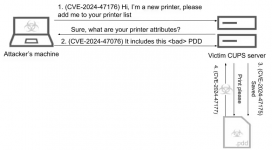Critical Flaw in Linux Printing System Raises Cybersecurity Alarms
Experts warn of potential for widespread attacks, while Linux community rushes to patch the vulnerability

In a development that has sent ripples through the cybersecurity world, researchers have uncovered a series of critical vulnerabilities in a core component of Linux operating systems. The flaws, found in the Common Unix Printing System (CUPS), could potentially allow malicious actors to execute unauthorized commands on millions of devices worldwide.Experts warn of potential for widespread attacks, while Linux community rushes to patch the vulnerability

The Discovery
The discovery, made by independent security researcher Simone Margaritelli, has prompted urgent warnings from cybersecurity experts and a scramble within the Linux community to develop and deploy patches."These vulnerabilities represent a significant threat to the Linux ecosystem," said Dr. Elena Rodriguez, chief security officer at CyberGuard Institute. "The widespread use of CUPS across various Linux distributions means that the potential attack surface is vast."
CUPS, an open-source printing system used in most Linux distributions, including popular variants like Ubuntu and Red Hat Enterprise Linux, has long been considered a stable and secure component. However, the newly discovered flaws challenge this assumption.
According to Margaritelli's report, an attacker could exploit these vulnerabilities to "silently replace existing printers' URLs with malicious ones, resulting in arbitrary command execution when a print job is started." This means that a seemingly innocuous action like printing a document could potentially compromise an entire system.
The implications of this vulnerability extend far beyond individual users. Many servers and enterprise systems rely on Linux, making this a potential vector for large-scale attacks on corporate and governmental infrastructure.
"We're looking at a situation where an attacker could potentially gain a foothold in critical systems through what most would consider a mundane function – printing," explained Mark Thompson, a senior analyst at the Center for Strategic and International Studies. "It's a stark reminder of how interconnected our digital systems are, and how vulnerabilities in seemingly peripheral components can have far-reaching consequences."
The Linux community, known for its rapid response to security threats, has mobilized to address the issue. Major distributions are working on patches, with some already releasing updates to mitigate the risk.
"We're taking this very seriously," said Sarah Chen, lead developer for a major Linux distribution. "Our team is working around the clock to patch these vulnerabilities and push updates to our users. In the meantime, we're advising system administrators to take precautionary measures, such as disabling unnecessary printing services and restricting network access to printing ports."
However, the nature of open-source software means that not all systems will be updated immediately, leaving a window of vulnerability that could be exploited by malicious actors.
The Debate
The discovery has also reignited debates about the security of open-source software. Proponents argue that the transparency of open-source development allows for quicker identification and patching of vulnerabilities. Critics, however, point to incidents like this as evidence of the need for more rigorous security audits."Open-source software is the backbone of much of our digital infrastructure," noted Dr. Rodriguez. "While it offers many advantages, this incident underscores the need for constant vigilance and proactive security measures in the open-source community."
The Path Forward
As the Linux community works to patch the vulnerability, cybersecurity experts are urging users and system administrators to remain alert. They recommend implementing temporary mitigations, such as disabling the CUPS browsing feature and restricting access to printing-related network ports.The incident serves as a potent reminder of the ongoing challenges in maintaining cybersecurity in an increasingly complex digital landscape. As our reliance on interconnected systems grows, so too does the importance of robust security measures and rapid response protocols.
"This is not just a Linux problem or an open-source problem," Thompson emphasized. "It's a wake-up call for the entire tech industry. We need to constantly reevaluate our assumptions about what is secure and what isn't."
As patches are developed and deployed, the cybersecurity community will be watching closely, mindful that in the cat-and-mouse game of digital security, today's solution could be tomorrow's vulnerability.
In the digital age, eternal vigilance is the price of security



